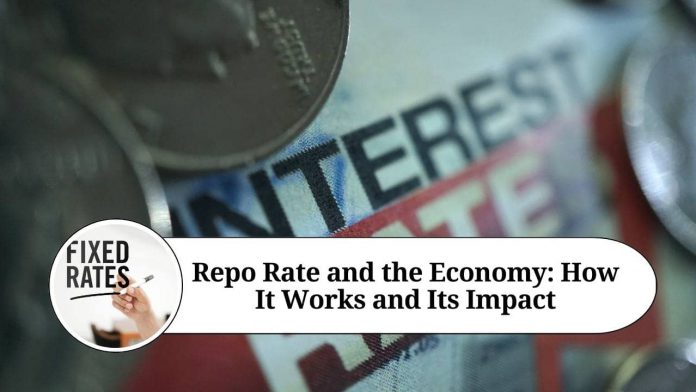Repo rate is a term that you may have heard in financial news or when discussing monetary policy. It is a key tool used by central banks to control the money supply and manage inflation. In this blog post, we will discuss what repo rate is, how it works, and its impact on the economy.
What is Repo Rate?
Repo rate, short for repurchase rate, is the rate at which the central bank of a country lends money to commercial banks. When banks need to borrow money to meet their liquidity needs, they can borrow from the central bank at the repo rate. The central bank uses repo rate as a tool to control the supply of money in the economy.
In a repo transaction, the commercial bank sells securities to the central bank with an agreement to buy them back at a later date. The difference between the sale price and the repurchase price is the interest charged on the transaction, which is the repo rate. This interest rate is essentially the cost of borrowing money from the central bank.
How Does Repo Rate Work?
The repo rate is set by the central bank’s monetary policy committee. The committee considers various factors, such as inflation, economic growth, and currency stability, when deciding on the repo rate. When the central bank wants to encourage borrowing and stimulate economic activity, it can lower the repo rate. This makes it cheaper for commercial banks to borrow money, and they can, in turn, pass on the lower cost of borrowing to their customers.
On the other hand, when the central bank wants to control inflation and curb excessive economic growth, it can increase the repo rate. This makes borrowing more expensive, and as a result, reduces the money supply in the economy. This, in turn, helps to control inflation and prevent overheating of the economy.
Impact of Repo Rate on the Economy
Repo rate has a significant impact on the economy. When the repo rate is low, borrowing becomes cheaper, and people are more likely to take out loans to buy homes, cars, and other big-ticket items. This, in turn, stimulates economic growth and job creation. On the other hand, when the repo rate is high, borrowing becomes more expensive, and people are less likely to take out loans, which can slow down economic growth.
Additionally, the repo rate can impact the value of a country’s currency. When the repo rate is higher in one country compared to another, investors are more likely to invest in the higher yielding currency, which can lead to an appreciation in the value of that currency. Conversely, a lower repo rate may lead to a depreciation in the currency value.
Conclusion
In conclusion, a repo rate is a key tool used by central banks to control the supply of money in the economy. By adjusting the repo rate, central banks can stimulate economic growth or control inflation. The repo rate has a significant impact on borrowing costs, which, in turn, affects economic growth, job creation, and currency values. Understanding the repo rate is essential for anyone interested in the financial markets or the broader economy.
Read Other Useful Blogs:
- Importance Of Cancelled Cheque
- Future Of E-Invoicing
- Business Operations With E-Way Bill
- Importance Of Cancelled Cheque
Frequently asked questions (FAQs) about repo rate:
Q1: What is repo rate?
Repo rate, short for repurchase rate, is the rate at which the central bank of a country lends money to commercial banks.
Q2: Why is repo rate important?
Repo rate is important because it is a key tool used by central banks to control the supply of money in the economy. By adjusting the repo rate, central banks can stimulate economic growth or control inflation.
Q3: How is repo rate determined?
Repo rate is determined by the central bank’s monetary policy committee, which considers various factors such as inflation, economic growth, and currency stability when deciding on the repo rate.
Q4: What happens when the repo rate is lowered?
When the repo rate is lowered, borrowing becomes cheaper, and people are more likely to take out loans to buy homes, cars, and other big-ticket items. This can stimulate economic growth and job creation.
Q5: What happens when the repo rate is raised?
When the repo rate is raised, borrowing becomes more expensive, and people are less likely to take out loans, which can slow down economic growth. This can help control inflation and prevent overheating of the economy.
Q6: How does repo rate impact currency values?
The repo rate can impact the value of a country’s currency. When the repo rate is higher in one country compared to another, investors are more likely to invest in the higher-yielding currency, which can lead to an appreciation in the value of that currency. Conversely, a lower repo rate may lead to a depreciation in the currency value.
Q7: How does repo rate impact the stock market?
The impact of repo rate on the stock market is indirect. When the repo rate is lowered, borrowing becomes cheaper, which can stimulate economic growth and job creation. This can lead to higher corporate profits and, in turn, higher stock prices. Conversely, when the repo rate is raised, borrowing becomes more expensive, which can slow down economic growth and lead to lower corporate profits and stock prices.
Q8: Who is affected by changes in repo rate?
Changes in repo rate can affect anyone who borrows money, whether it is an individual, a business, or a government. Additionally, changes in repo rate can impact currency values and the stock market, which can have broader economic implications.




















